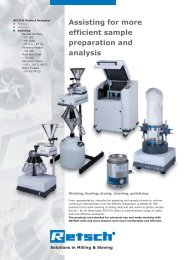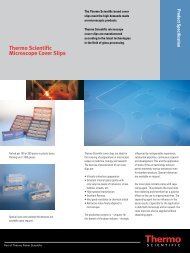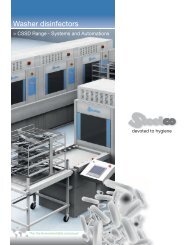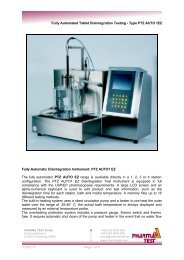TAM AIR Brochure - TA Instruments
TAM AIR Brochure - TA Instruments
TAM AIR Brochure - TA Instruments
You also want an ePaper? Increase the reach of your titles
YUMPU automatically turns print PDFs into web optimized ePapers that Google loves.
A POWERFUL TOOL FOR THE STUDY OF<br />
CEMENT HYDRATION PROCESSES<br />
Instrument of choice for standardized testing on cement<br />
Determining the heat of hydration of cement is important and traditionally, the heat of<br />
hydration has been determined by measuring the heat of solution (ASTM C186). More recently,<br />
isothermal calorimetry tests using <strong><strong>TA</strong>M</strong> Air are increasing because it accurately and reliably<br />
measures the heat of hydration (ASTM C1702). The samples tested in the <strong><strong>TA</strong>M</strong> Air are usually<br />
paste samples, where the cement hydration process can continuously be followed over time. The<br />
shape of the heat flow curve will reflect the cement hydration process and the different phases of<br />
the complex process can be determined. The addition of admixtures will change the shape of the<br />
heat flow curve, and the admixture effect can be quantified. The integrated heat flow over time will<br />
give the extent of hydration. Using isothermal calorimetry, the heat of hydration is measured with<br />
<strong><strong>TA</strong>M</strong> Air by monitoring the heat flow from the specimen while both the specimen and the surrounding<br />
environment are maintained at the same temperature. The <strong><strong>TA</strong>M</strong> Air is widely used for<br />
studying the reaction kinetics of pure cement pastes as well as the temperature dependence<br />
of the reaction. <strong><strong>TA</strong>M</strong> Air is an excellent tool for quality control in cement plants, for optimization<br />
of additives to give a cement a certain property as well as a general research tool for the<br />
cement laboratory.<br />
Phase 1: Rapid initial process - Dissolution of ions and initial hydration<br />
Phase 2: Dormant period - Associated with a low heat evolution and<br />
slow dissolution of silicates<br />
Phase 3: Acceleration period - Silicate hydration<br />
Phase 4: Retardation period - Sulphate depletion and slowing down of<br />
the silicate hydration process<br />
Heat Evolution / mW/g<br />
5<br />
4 1<br />
3<br />
3<br />
2<br />
1<br />
2<br />
0<br />
0 10<br />
4<br />
20 30 40 50 60<br />
Time (h)<br />
4 5
















